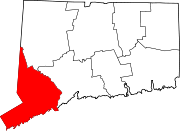History
On May 15, 1656, the Court of the Colony of Connecticut in Hartford affirmed that the town of Stratford included all of the territory 12 miles (19 km) inland from Long Island Sound, between the Housatonic River and the Fairfield town line, to include the southern portion of present-day Monroe. In 1662, Stratford selectmen Lt. Joseph Judson, Captain Joseph Hawley and John Minor secured all the written deeds of transfer from the Golden Hill Paugussett Indian Nation for this vast territory that comprises the present-day towns of Trumbull, Shelton and Monroe. In 1671, Stratford purchased from the Paugusset Indians the territory which included the remainder of the northern portions of Monroe, Trumbull and Shelton, in what is known as "The White Hills Purchase", and officially annexed it to the Township of Stratford.
Monroe incorporated as a town in 1823. The community is named after James Monroe, fifth President of the United States. [5]
On August 18, 2024 the town suffered from a flash flood which poured over 10 inches of rain on the town, causing many roads in town to flood and wash out, leaving many stranded. This included the Route 34 bridge near the Lake Zoar drive in getting washed away completely, leaving the road closed for an extended period of time.
Demographics
Historical population| Census | Pop. | Note | %± |
|---|
| 1830 | 1,522 | | — |
|---|
| 1840 | 1,351 | | −11.2% |
|---|
| 1850 | 1,442 | | 6.7% |
|---|
| 1860 | 1,382 | | −4.2% |
|---|
| 1870 | 1,226 | | −11.3% |
|---|
| 1880 | 1,157 | | −5.6% |
|---|
| 1890 | 994 | | −14.1% |
|---|
| 1900 | 1,043 | | 4.9% |
|---|
| 1910 | 1,002 | | −3.9% |
|---|
| 1920 | 1,161 | | 15.9% |
|---|
| 1930 | 1,221 | | 5.2% |
|---|
| 1940 | 1,728 | | 41.5% |
|---|
| 1950 | 2,892 | | 67.4% |
|---|
| 1960 | 6,402 | | 121.4% |
|---|
| 1970 | 12,047 | | 88.2% |
|---|
| 1980 | 14,010 | | 16.3% |
|---|
| 1990 | 16,896 | | 20.6% |
|---|
| 2000 | 19,247 | | 13.9% |
|---|
| 2010 | 19,479 | | 1.2% |
|---|
| 2020 | 18,825 | | −3.4% |
|---|
| 2021 (est.) | 18,764 | | −0.3% |
|---|
|
As of the 2020 United States Census, there were 18,825 people living in the town. The racial makeup of the town was 84.6% White, 2.4% African American, 6.2% Asian, and 4.9% from two or more races. Hispanic or Latino people of any race were 6.8% of the population.
As of the census [7] of 2000, there were 19,247 people, 6,481 households, and 5,346 families residing in the town. The population density was 736.5 inhabitants per square mile (284.4/km2). There were 6,601 housing units at an average density of 252.6 per square mile (97.5/km2). The racial makeup of the town was 95.8% White, 0.20% African American, 0.08% Native American, 2.62% Asian, 0.50% from other races, and 0.83% from two or more races. Hispanic or Latino people of any race were 2.20% of the population.
There were 6,481 households, out of which 42.5% had children under the age of 18 living with them, 74.0% were married couples living together, 6.0% had a female householder with no husband present, and 17.5% were non-families. Of all households, 14.9% were made up of individuals, and 6.6% had someone living alone who was 65 years of age or older. The average household size was 2.96 and the average family size was 3.31.
In the town, the population was spread out, with 29.1% under the age of 18, 4.8% from 18 to 24, 29.9% from 25 to 44, 25.7% from 45 to 64, and 10.5% who were 65 years of age or older. The median age was 38 years. For every 100 females, there were 96.5 males. For every 100 females age 18 and over, there were 93.5 males.
The median income for a household in the town was $85,000 and the median income for a family was $92,514. Males had a median income of $61,109 versus $41,572 for females. The per capita income for the town was $34,161. About 1.8% of families and 2.6% of the population were below the poverty line, including 2.6% of those under age 18 and 5.5% of those age 65 or over.
Education
Monroe Public Schools oversees public education and includes approximately 4,000 students, in three elementary schools (Fawn Hollow, Monroe Elementary, and Stepney Elementary), two middle schools (Jockey Hollow and STEM Academy), and one high school (Masuk High School).
In 2011, STEM Academy was opened at Masuk High School as an additional middle school option for Monroe's 6th, 7th, and 8th graders. [12]
Chalk Hill Middle School housed Monroe's 5th and 6th graders from 1969 to 2011 (when it was closed due to shifting population and budget issues). [13] From 2012 to 2016, Chalk Hill was the home of Sandy Hook Elementary School in Newtown following the December 14, 2012, shooting. [14]
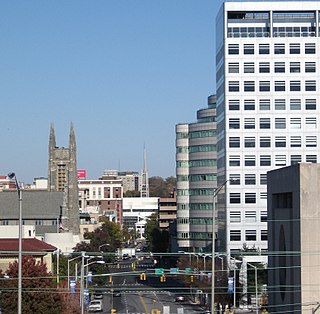
Fairfield County is a county in the southwestern corner of the U.S. state of Connecticut. It is the most populous county in the state and was also its fastest-growing from 2010 to 2020. As of the 2020 census, the county's population was 957,419, representing 26.6% of Connecticut's overall population. The closest to the center of the New York metropolitan area, the county contains four of the state's top 7 largest cities—Bridgeport (1st), Stamford (2nd), Norwalk (6th), and Danbury (7th)—whose combined population of 433,368 is nearly half the county's total population.

Shelton is a city in Fairfield County, Connecticut, United States. The population was 40,869 at the 2020 United States Census. The city is part of the Naugatuck Valley Planning Region.

Trumbull is a town located in Fairfield County, Connecticut, United States. The town is part of the Greater Bridgeport Planning Region, and borders on the cities of Bridgeport and Shelton, as well as the towns of Stratford, Fairfield, Easton and Monroe. The population was 36,827 during the 2020 census. Trumbull was the home of the Golden Hill Paugussett Indian Nation for thousands of years before the English settlement was made in 1639. The town was named after Jonathan Trumbull (1710–1785), a merchant, patriot and statesman, at its incorporation in 1797. Aviation pioneer Igor Sikorsky lived in Trumbull during his active years when he designed, built, and flew fixed-wing aircraft and put the helicopter into mass production for the first time.

Stratford is a town in Fairfield County, Connecticut, United States. It is situated on Long Island Sound at the mouth of the Housatonic River. The town is part of the Greater Bridgeport Planning Region, and the Bridgeport–Stamford–Norwalk Metropolitan Statistical Area. It was settled by Puritans in 1639.

Stamford-Bridgeport-Norwalk is a metropolitan area in the U.S. state of Connecticut. The area is located in Southwestern Connecticut. In its most conservative form, the area consists of the City of Bridgeport and five surrounding towns—Easton, Fairfield, Monroe, Stratford, and Trumbull. This definition of the Stamford area has a population of more than 305,000 and is within the Stamford -Bridgeport-Norwalk-Danbury metropolitan statistical area, which consists of all of Fairfield County, Connecticut. The estimated 2015 county population was 948,053. The area is numbered as part of the New York-Newark Combined Statistical Area NY-NJ-CT-PA by the United States Census Bureau.

Route 108 in the U.S. state of Connecticut, locally called Nichols Avenue and Huntington Turnpike, is a two-lane state highway that runs northerly from US 1, Boston Post Road in Stratford, through Trumbull, to Route 110 in downtown Shelton. Originally called the Farm Highway, it was laid out to the south side of Mischa Hill in Trumbull on December 7, 1696 and is considered to be the third oldest documented highway in Connecticut after the Mohegan Road in Norwich (1670) and the Boston Post Road or US 1 (1673).

Route 111 is a state highway in southwestern Connecticut, United States, running from the Merritt Parkway (Route 15) in Trumbull to Route 34 in Monroe. The junction with the Merritt Parkway is currently the only single-point urban interchange (SPUI) in the entire state.

Greater Bridgeport Transit (GBT) is a transit service serving the Greater Bridgeport region of the U.S. state of Connecticut. Greater Bridgeport Transit was established in 1971 in anticipation of diminished bus service by the Connecticut Company, which officially ceased operations in Bridgeport in 1972. GBT provides local bus service to the cities/towns of Bridgeport, Trumbull, Stratford, Milford, Fairfield, Westport, Shelton, and Monroe. The fleet is composed of mainly New Flyer Xcelsior and New Flyer Low Floor, as well as Gillig Low Floor and two Proterra Catalyst BE40 models.

The Stevenson Dam Bridge carries Connecticut Route 34 over the Housatonic River in the U.S. state of Connecticut, connecting the town of Monroe to the town of Oxford.

Trumbull, a town in Fairfield County, Connecticut, in the New England region of the United States, was originally home to the Golden Hill Paugussett Indian Nation, and was colonized by the English during the Great Migration of the 1630s as a part of the coastal settlement of Stratford.
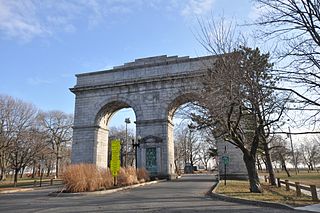
Bridgeport is the most populous city in the U.S. state of Connecticut and the fifth-most populous city in New England, with a population of 148,654 in 2020. Located in eastern Fairfield County at the mouth of the Pequonnock River on Long Island Sound, it is a port city 60 miles (97 km) from Manhattan and 40 miles (64 km) from The Bronx. It borders the towns of Trumbull to the north, Fairfield to the west, and Stratford to the east. Bridgeport and other towns in Fairfield County make up the Greater Bridgeport Planning Region, as well as the Bridgeport–Stamford–Norwalk–Danbury metropolitan statistical area, the second largest metropolitan area in Connecticut. The Bridgeport–Stamford–Norwalk–Danbury metropolis forms part of the New York metropolitan area.

The Pequonnock River is a 16.7-mile-long (26.9 km) waterway in eastern Fairfield County, Connecticut. Its watershed is located in five communities, with the majority of it located within Monroe, Trumbull, and Bridgeport. The river has a penchant for flooding, particularly in spring since the removal of a retention dam in Trumbull in the 1950s. There seems to be a sharp difference of opinion among historians as to just what the Indian word Pequonnock signifies. Some insist it meant cleared field or open ground; others are sure it meant broken ground; while a third group is certain it meant place of slaughter or place of destruction.

The Paugussett Trail is a 14-mile (23 km) Blue-Blazed hiking trail "system" in the lower Housatonic River valley in Fairfield County and, today, is entirely in Shelton and Monroe, Connecticut. Much of the trail is in Indian Well State Park and the Town of Monroe's Webb Mountain Park. The mainline trail is primarily southeast to northwest with three short side or spur trails.
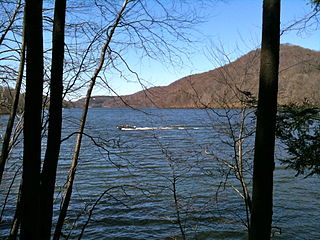
The Lillinonah Trail is a 5.9-mile (9.5 km) Blue-Blazed hiking trail "system" in the lower Housatonic River valley in Fairfield County and, today, is entirely in Newtown. Most of the trail is in the upper block of Paugussett State Forest.
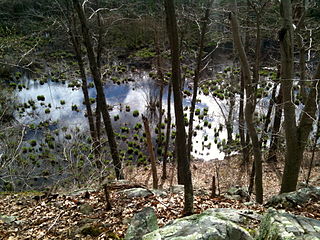
The Aspetuck Valley Trail is a 5.9-mile (9.5 km) Blue-Blazed hiking trail in the Aspetuck River Valley area of Fairfield County in the towns of Newtown, Easton and Redding Connecticut.

The Zoar Trail is a 6.5-mile (10.5 km) Blue-Blazed hiking trail "system" in the lower Housatonic River valley in Fairfield County, Connecticut and is entirely in the Sandy Hook section of Newtown in the lower block of Paugussett State Forest.
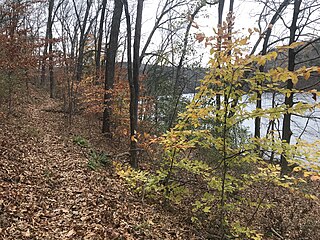
The Kettletown Trails are a 4.6-mile (7.4 km) Blue-Blazed hiking trail "system" in the lower Housatonic River valley in Fairfield County and are in the towns of Southbury and Oxford -- primarily in the Kettletown State Park and the Jackson Cove recreation area belonging to the town of Oxford.

Lake Zoar is a reservoir on the Housatonic River in the U.S. state of Connecticut. It was formed by the completion of the Stevenson Dam, which flooded an area of Oxford and Stevenson named "Pleasantvale" or "Pleasant Vale". "Connecticut's Lakes Reflect Our History, Present". Retrieved 2018-04-02. The towns of Monroe, Newtown, Oxford, and Southbury border Lake Zoar. The name Zoar originates from corner of Newtown and Monroe that once called itself Zoar after the Biblical city Zoara near the Dead Sea.

Stepney, also referred to as Stepney Village and Upper Stepney, is a district of the town of Monroe, Connecticut, and on the Connecticut State Register of Historic Places. Consisting of approximately 8 square miles (21 km2), Stepney extends from the Trumbull town line, along Route 25, to the Newtown town line. It was listed as a census-designated place prior to the 2020 census.

Long Hill is a neighborhood and census-designated place (CDP) in the town of Trumbull in Fairfield County, Connecticut, United States. It is located west of the Pequonnock River. The main thoroughfare is Connecticut Route 111, present-day Main Street. It was listed as a census-designated place prior to the 2020 census.














